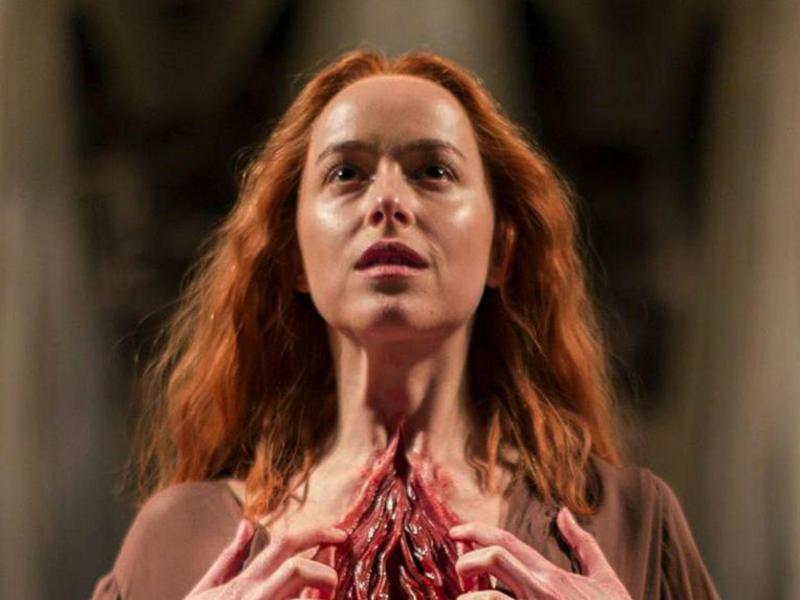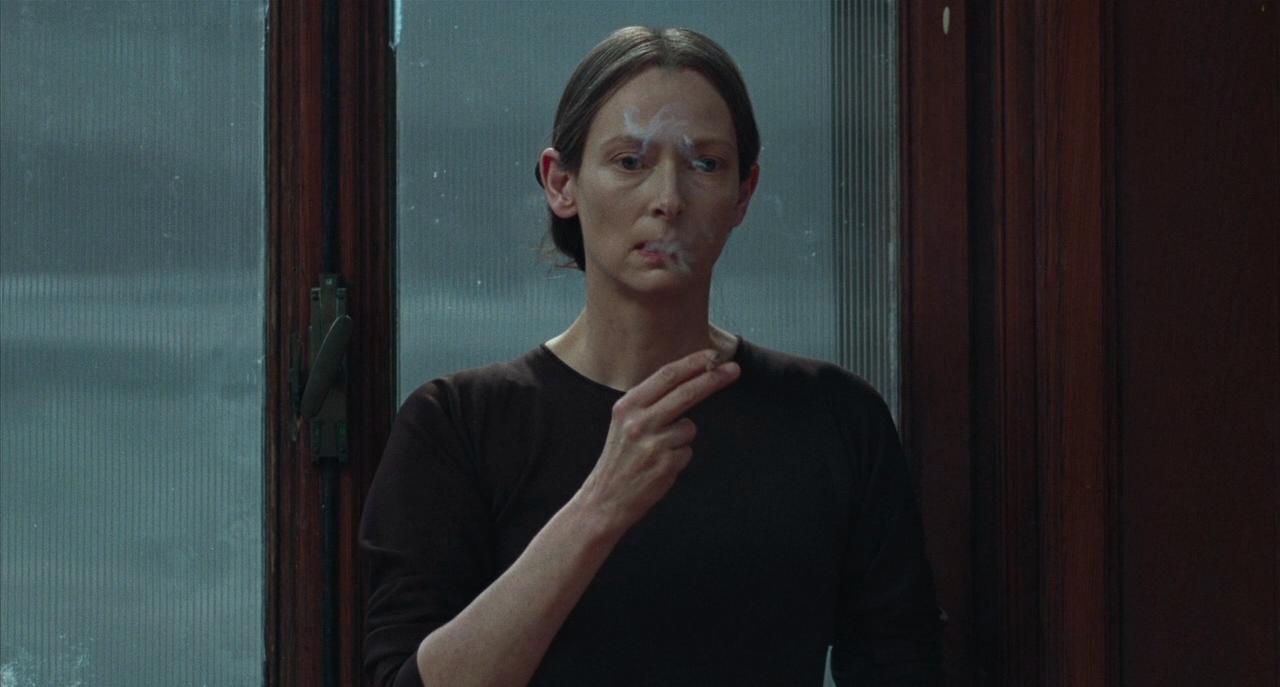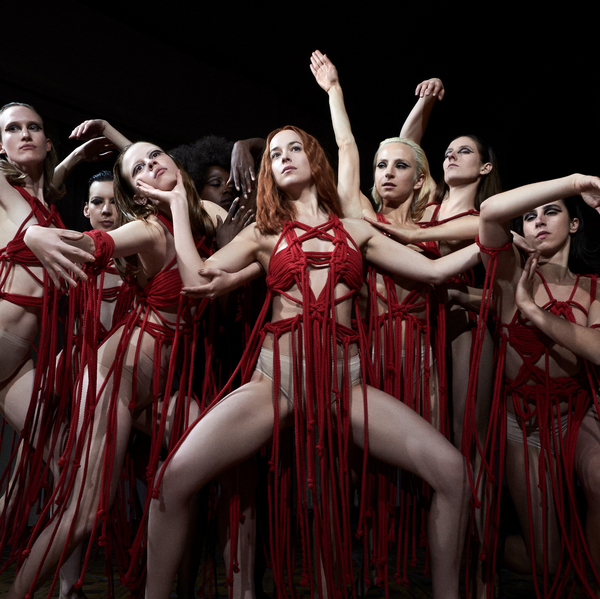Suspiria review - kindly, slow-motion grand guignol | reviews, news & interviews
Suspiria review - kindly, slow-motion grand guignol
Suspiria review - kindly, slow-motion grand guignol
Horror shocker remade with heartfelt emotion

Luca Guadagnino will not be rushed. His Suspiria is long, slow, sometimes torpid and diffuse. His 1977 is a resonant historical period, in which winter light weighs on a Berlin schismed by the Wall, haunted by the war, and assaulted by Baader-Meinhof and riot police.
The witches’ coven of dance teachers secretly manipulating their female students at the Markos Academy are also a chain-smoking feminist collective in chunky jumpers, who let their hair down at the bohemian Paris Bar. They are as riven with factions as Germany itself. Ancient Madame Markos lurks in the basement, as she did for Argento, pulsing with evil refusal to relinquish power. The school’s visible queen, Madame Blanc, (Tilda Swinton pictured above) with her long black dress and long grey hair, towers over her students, ruling them with fearsome kindness. Such ambiguity is a speciality of Tilda Swinton, who plays both women, and a decrepit but dogged male psychiatrist, Dr. Josef Klemperer. Crippled by guilt at his wife’s fate in the war, he limps through Berlin on behalf of a Markos escapee (Chloe Grace Moretz), who memorably warns him of the teachers she insists are witches: “They’ll hollow me out and eat my cunt on a plate.” Swinton’s Herr Doktor and Madames deserve an androgyne Oscar. Dakota Johnson’s Susie Bannon (pictured below centre) drawn to the Academy from her Mennonite American home, is a quietly beautiful, subtly powerful balance to its malignancy, whose red tresses taunt the muted colour scheme.
Ancient Madame Markos lurks in the basement, as she did for Argento, pulsing with evil refusal to relinquish power. The school’s visible queen, Madame Blanc, (Tilda Swinton pictured above) with her long black dress and long grey hair, towers over her students, ruling them with fearsome kindness. Such ambiguity is a speciality of Tilda Swinton, who plays both women, and a decrepit but dogged male psychiatrist, Dr. Josef Klemperer. Crippled by guilt at his wife’s fate in the war, he limps through Berlin on behalf of a Markos escapee (Chloe Grace Moretz), who memorably warns him of the teachers she insists are witches: “They’ll hollow me out and eat my cunt on a plate.” Swinton’s Herr Doktor and Madames deserve an androgyne Oscar. Dakota Johnson’s Susie Bannon (pictured below centre) drawn to the Academy from her Mennonite American home, is a quietly beautiful, subtly powerful balance to its malignancy, whose red tresses taunt the muted colour scheme.
The first magical dismantling of a body, flesh and bone jerking in a sack of skin, is dance in extremis, and public choreography and cellar rituals are frequently rhymed. Though Guadagnino is too languid for Argento’s total Roman excess, he’s capable of grand guignol, as the violence which exploded in A Bigger Splash proved. The high design and fashion of this 35mm-shot, simulated Seventies is also decadently extreme. Argento’s seeming misogyny and sadism has become something else in Guadagnino’s female world. This Suspiria is an argument about art, and how to live. “Today we must break the nose of every beautiful thing,” Blanc says of her dance regime. But there are other possibilities, embodied in Susie. Is she sacrificial lamb, or she-wolf? As the title of Guadagnino’s third film declared, she certainly exists to say: I am love. The most secret part of the director’s bloody chamber is built from unexpected kindness. When he finally paints the screen red, it is more than genre novice Kubrick’s mistake in The Shining, where tidal waves of gore crudely signified horror. The blood-gouts of this last orgy-dance are a rejuvenating rain.
Argento’s seeming misogyny and sadism has become something else in Guadagnino’s female world. This Suspiria is an argument about art, and how to live. “Today we must break the nose of every beautiful thing,” Blanc says of her dance regime. But there are other possibilities, embodied in Susie. Is she sacrificial lamb, or she-wolf? As the title of Guadagnino’s third film declared, she certainly exists to say: I am love. The most secret part of the director’s bloody chamber is built from unexpected kindness. When he finally paints the screen red, it is more than genre novice Kubrick’s mistake in The Shining, where tidal waves of gore crudely signified horror. The blood-gouts of this last orgy-dance are a rejuvenating rain.
Guadagnino seems too earthbound for his subject’s magic, until he suffuses it with emotion. There was a shimmer in the light when I left the cinema, a little extra leaking into reality, like an after-image, or a spell.
rating
Share this article
The future of Arts Journalism
You can stop theartsdesk.com closing!
We urgently need financing to survive. Our fundraising drive has thus far raised £49,000 but we need to reach £100,000 or we will be forced to close. Please contribute here: https://gofund.me/c3f6033d
And if you can forward this information to anyone who might assist, we’d be grateful.

Subscribe to theartsdesk.com
Thank you for continuing to read our work on theartsdesk.com. For unlimited access to every article in its entirety, including our archive of more than 15,000 pieces, we're asking for £5 per month or £40 per year. We feel it's a very good deal, and hope you do too.
To take a subscription now simply click here.
And if you're looking for that extra gift for a friend or family member, why not treat them to a theartsdesk.com gift subscription?
more Film
 Can I get a Witness? review - time to die before you get old
Ann Marie Fleming directs Sandra Oh in dystopian fantasy that fails to ignite
Can I get a Witness? review - time to die before you get old
Ann Marie Fleming directs Sandra Oh in dystopian fantasy that fails to ignite
 Happyend review - the kids are never alright
In this futuristic blackboard jungle everything is a bit too manicured
Happyend review - the kids are never alright
In this futuristic blackboard jungle everything is a bit too manicured
 Robert Redford (1936-2025)
The star was more admired within the screen trade than by the critics
Robert Redford (1936-2025)
The star was more admired within the screen trade than by the critics
 Blu-ray: The Sons of Great Bear
DEFA's first 'Red Western': a revisionist take on colonial expansion
Blu-ray: The Sons of Great Bear
DEFA's first 'Red Western': a revisionist take on colonial expansion
 Spinal Tap II: The End Continues review - comedy rock band fails to revive past glories
Belated satirical sequel runs out of gas
Spinal Tap II: The End Continues review - comedy rock band fails to revive past glories
Belated satirical sequel runs out of gas
 Downton Abbey: The Grand Finale review - an attemptedly elegiac final chapter haunted by its past
Noel Coward is a welcome visitor to the insular world of the hit series
Downton Abbey: The Grand Finale review - an attemptedly elegiac final chapter haunted by its past
Noel Coward is a welcome visitor to the insular world of the hit series
 Islands review - sunshine noir serves an ace
Sam Riley is the holiday resort tennis pro in over his head
Islands review - sunshine noir serves an ace
Sam Riley is the holiday resort tennis pro in over his head
 theartsdesk Q&A: actor Sam Riley on playing a washed-up loner in the thriller 'Islands'
The actor discusses his love of self-destructive characters and the problem with fame
theartsdesk Q&A: actor Sam Riley on playing a washed-up loner in the thriller 'Islands'
The actor discusses his love of self-destructive characters and the problem with fame
 Honey Don’t! review - film noir in the bright sun
A Coen brother with a blood-simple gumshoe caper
Honey Don’t! review - film noir in the bright sun
A Coen brother with a blood-simple gumshoe caper
 The Courageous review - Ophélia Kolb excels as a single mother on the edge
Jasmin Gordon's directorial debut features strong performances but leaves too much unexplained
The Courageous review - Ophélia Kolb excels as a single mother on the edge
Jasmin Gordon's directorial debut features strong performances but leaves too much unexplained
 Blu-ray: The Graduate
Post #MeToo, can Mike Nichols' second feature still lay claim to Classic Film status?
Blu-ray: The Graduate
Post #MeToo, can Mike Nichols' second feature still lay claim to Classic Film status?

Add comment